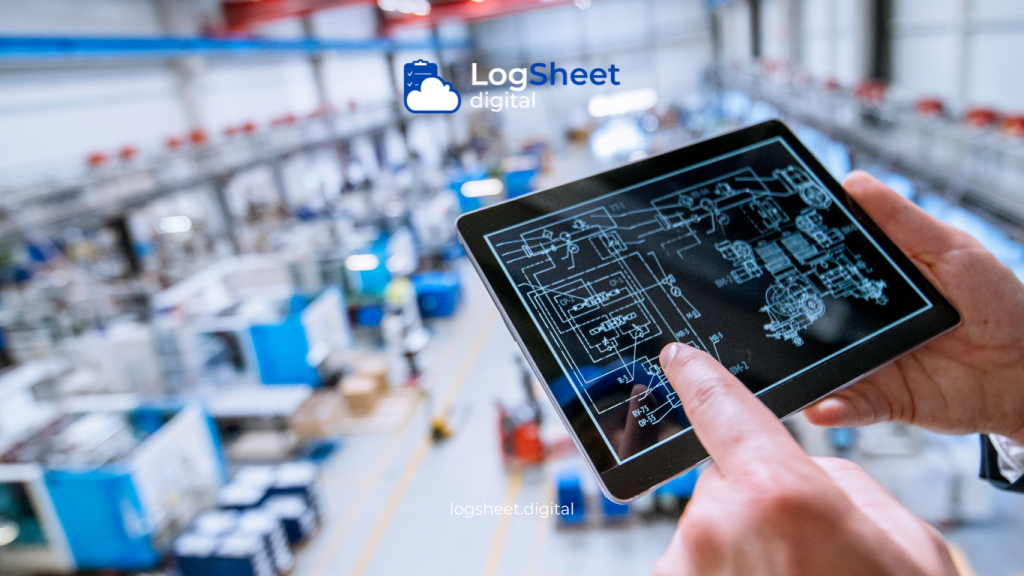Industry 4.0 has brought a major revolution in the world of manufacturing and production. By combining digital technology and automation, industries can now achieve unprecedented levels of efficiency, productivity, and flexibility. One of the key components in the implementation of Industry 4.0 is the digital logsheet. In this article, we will discuss how digital logsheets have become a cornerstone in the integration and automation of production, as well as how their usage drives transformation across various industries.
Understanding Digital Logsheets in the Context of Industry 4.0

Read More: Data Security in Digital Logsheets: Challenges and Security Strategies in Calibration
Industry 4.0 is an era of digital transformation focused on integrating advanced technologies such as Internet of Things (IoT), artificial intelligence (AI), cloud computing, and automation into production processes. One of the crucial elements in this transformation is the digital logsheet, which replaces manual recording methods with technology-based systems to monitor, record, and analyze production data in real-time.
Digital logsheets allow companies to manage operational data more accurately, efficiently, and transparently. Data collected from machines and production processes can be accessed directly by the involved teams, making data-driven decision-making easier and minimizing potential human errors.
Importance of Digital Logsheets in Industry 4.0

Read More: Application of Digital Logsheets in Asset Security Monitoring
Digital logsheets are vital elements in companies’ efforts to integrate technology and achieve the goals of Industry 4.0. Here are some reasons why digital logsheets are essential in this context:
1. Increased Accuracy and Data Precision
Manual recording processes often lead to recording errors, delays, and inconsistent data. With digital logsheets, data is recorded automatically and in real-time, ensuring the accuracy and consistency of the information obtained.
2. Better Performance Monitoring
Digital logsheets enable direct monitoring of production processes through sensors installed on each machine. This provides production managers with clearer information about equipment conditions and operational performance, allowing them to take preventive or corrective actions more quickly.
3. Operational Efficiency
By automating data recording processes, digital logsheets save significant time. Employees no longer need to manually record data, which means they can focus on other more productive tasks. Additionally, these savings also reduce operational costs associated with the use of paper, ink, and other equipment.
4. Supports Data-Driven Decision Making
With data available in real-time, managers can make decisions more quickly and accurately. Decisions based on accurate and up-to-date data are more effective in improving performance and production efficiency.
How Digital Logsheets Integrate Production Processes

Read More: Data Security in Digital Logsheets: Challenges and Solutions
Integration is at the core of Industry 4.0. In production processes, this integration involves combining various systems and devices so that they all work in harmony. Digital logsheets play an important role in connecting various elements in the production chain, from machines to operators and managers.
1. IoT Connectivity
Digital logsheets are often connected with IoT devices installed on various production machines. These IoT sensors collect data, such as temperature, pressure, and machine speed, which is then sent to the digital logsheet system. This connectivity allows for constant monitoring and automation of the recording process.
2. Integration with ERP Systems
Digital logsheets can be integrated with Enterprise Resource Planning (ERP) systems, allowing for holistic management of company resources. Data collected through digital logsheets can be used to update inventory reports, production status, and maintenance needs. This strengthens workflows across departments, from production to management and finance.
3. More Efficient Time and Resource Management
With the integration of digital logsheets, companies can utilize their resources more efficiently. A more organized production process helps reduce waste, maximize operating time, and ensure that every part of the process runs according to plan.
Automation with Digital Logsheets: Enhanced Efficiency

Read More: The Importance of Digital Check Patrols for Factory Warehouse Security
Automation is one of the main components of Industry 4.0. In the context of digital logsheets, automation enables data recording and processing without human intervention. Several aspects of automation optimized with digital logsheets include:
1. Automatic Recording
Digital logsheets allow for automatic data recording through sensors and software, eliminating the need for time-consuming manual recording. This not only saves time but also improves the accuracy of the recorded data.
2. Automatic Alerts and Alarms
Digital logsheets are often equipped with automatic alarm features that alert operators when anomalies occur in the production process. These alerts enable companies to take proactive measures to prevent further issues, such as machine damage or operational disruptions.
3. Predictive Analytics
With the ability of digital logsheets to continuously collect data, companies can use predictive analytics to forecast when machines will need maintenance or repairs. This approach reduces unplanned downtime and extends the lifespan of machines.
Benefits of Digital Logsheets in Production Data Management

The advantages of digital logsheets in production data management cannot be overlooked. Here are some key benefits:
1. Data Transparency
With digital logsheets, all production data can be viewed and accessed in real-time by authorized parties. As a result, this enhances transparency in managing the production process. Consequently, it allows for better monitoring and ultimately ensures compliance with quality standards and regulations. Moreover, this increased visibility can lead to quicker identification of potential issues, further improving overall efficiency.
2. Faster Data Processing
Data recorded digitally can be processed more quickly than manual data. This allows companies to quickly identify trends or issues, as well as respond more rapidly to changing conditions in the field.
3. Improved Team Collaboration
Since production data can be accessed by various teams, including management, operators, and maintenance, collaboration among teams can be enhanced. Teams can work together to identify problems and find solutions based on the same data.
Challenges and Solutions in Implementing Digital Logsheets

Read More: Digital Logsheets: Transparency and Warehouse Security
Despite the many benefits of digital logsheets, their implementation does not always go smoothly. Here are some common challenges and their solutions:
1. High Implementation Costs
One of the main challenges in adopting digital logsheets is the initial costs required to implement this technology. However, the long-term solution is to leverage the savings from operational costs and productivity improvements gained after the system is in place.
2. Data Security Concerns
Since data is stored digitally, there are concerns about cybersecurity risks. The solution is to implement strict security protocols, such as data encryption and the use of robust firewalls.
3. Lack of Digital Skills
Some companies may encounter challenges in training their employees to use new technologies. However, the solution lies in providing adequate training. By doing so, companies can ensure that all employees fully understand how digital logsheets work. Furthermore, this investment in training can enhance overall productivity and ease the transition to new systems.
Case Study: Implementation of Digital Logsheets in Industry

Read More: Optimizing Production Processes Through the Implementation of Digital Logsheets
A large electronics company in Asia has adopted digital logsheets to optimize its production processes. Before implementation, the company faced delays in production due to inaccurate manual recording. After switching to digital logsheets, they successfully increased efficiency by 20%, reduced machine downtime, and obtained more accurate data for performance analysis.
Conclusion

Read More: Innovation in Digital Logsheets for Monitoring Industrial Operational Processes
Digital logsheets are an essential pillar in the integration and automation of production processes in the Industry 4.0 era. They enhance efficiency, accuracy, and data transparency while providing companies with the necessary tools to monitor and analyze their operations in real-time. By leveraging digital logsheets, businesses can adapt to the challenges of Industry 4.0 and achieve greater productivity and competitive advantage.






comments (0)